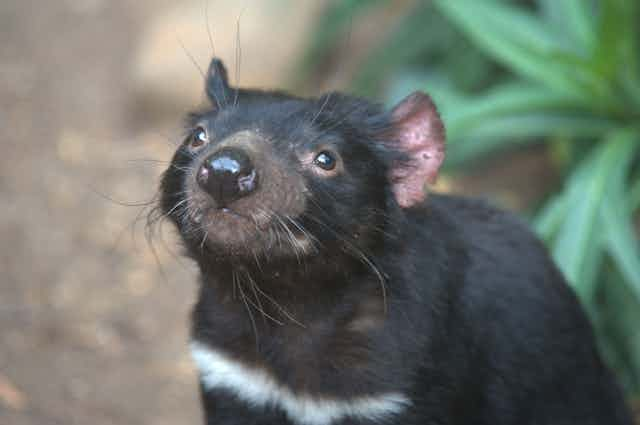For the past 20 years, an infectious cancer has been killing wild Tasmanian devils, creating a massive challenge for conservationists. But new research, published today in Nature Communications, suggests that devils are evolving rapidly in response to their highly lethal transmissible cancer and that they could ultimately save themselves.
Cancer is usually a disease that arises and dies with its host. In vertebrates, only two known types – Canine Transmissible Venereal Cancer in dogs and Devil Facial Tumour Disease (DFTD) – have taken the extraordinary evolutionary step of becoming transmissible. These cancers can grow not just within their host but can spread to other individuals. Because the cancer cells are all descendants of one mutant cell, the cancer is effectively immortal.
To grow in the new host, the tumour cell must evade detection and rejection by the immune system. Both the devil and dog transmissible cancers have sophisticated mechanisms for hiding from the host’s immune system. Our research suggests that the devil is nevertheless evolving resistance to the disease.
Ecological disaster
The Tasmanian devil is too important to lose – and this would seem careless following the extinction of the thylacine, the world’s largest marsupial predator, in the 1930s. Since the thylacine’s extinction, devils have stepped up to the role of top marsupial predator, keeping numbers of destructive feral cats at bay in Tasmania. With the decline of the devils, invasive species have become more active.
Since it was first detected in northeastern Tasmania in the mid-1990s, DFTD has spread slowly southward and westward. It will reach all parts of Tasmania within a few years; only the far northwest coast and parts of the southwest are still disease-free.

Devil populations have declined by at least 80%, and by more than 90% in some areas within six years of local disease outbreak.
DFTD kills most devils at sexual maturity. Before the disease arrived, most devils produced three litters over their lifetime. Most now raise only one.
The cascading effects of the loss of Tasmania’s top predator on the rest of the ecosystem could lead to loss of further species. Already, feral cats have increased activity and small mammals on which cats prey have declined.
Cats may also be preventing recovery of the eastern quoll. Brushtail possums behave as if devils were already extinct, grazing freely on pasture in the open.
Evolution in action
Our research has been a truly international effort. We used data collected by Menna Jones at the University of Tasmania since 1999. This archive of tissue samples now represents one of the best resources globally for studying evolution of an emerging infectious disease in wildlife.
Andrew Storfer at Washington State University and Paul Hohenlohe at the University of Idaho compared the frequency of genes in devils in regions before DFTD arrived to devils 8-16 years after DFTD arrived.
We identified significant changes in two small regions in the DNA samples of devils from regions with DFTD. Five of seven genes in the two regions were related to cancer or immune function in other mammals, suggesting that Tasmanian devils are indeed evolving resistance to DFTD. Evolution is often thought of as a slow process, but these changes have occurred in as few as 4–8 generations of devils since disease outbreak.
Devils are surviving at our long-term sites, despite models that predicted extinction. Previously, studies have shown that devils with lower rates of DFTD showed specific changes in their immune response. Our genetic results might explain why.
New infectious diseases put strong pressure on their hosts to evolve, leading to rapid changes in resistance or tolerance. Rapid evolution requires pre-existing genetic variation. Our results are surprising because Tasmanian devils have low levels of genetic diversity.
Evolution doesn’t just act on the devils; it also also acts on the disease. The disease evolves to not kill the host before it can spread to another host, but also to overcome the host’s defences. Over the long term, pathogen (the cause of the disease) and host usually evolve to live together as rabbits and Myxoma virus have evolved together.
Our results suggest that devils in the wild may save themselves through evolution. However, it is essential for managers to develop strategies that help the devils do so. For example, releasing fully susceptible devils that have had no exposure to the disease into populations where resistance is developing is likely to be counterproductive.
DFTD presents a unique opportunity to study the early stages of the evolution of a new disease and transmissible cancer with its animal host. Ultimately, through future research, we may understand how cancers can become transmissible and how their hosts respond.

